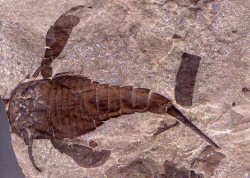Eurypterid
|
|
| Eurypterids Conservation status: Fossil | ||||||||
|---|---|---|---|---|---|---|---|---|
 | ||||||||
| Scientific classification | ||||||||
| ||||||||
| Orders | ||||||||
|
many, all extinct |
The eurypterids were the largest known arthropods that ever lived. They are members of the extinct class Eurypterida and predate the earliest fishes. The largest, such as Pterygotus, reached 2 meters or more in length, but most species were less than 20 cm. They were formidable predators among the coral reefs that thrived in the warm, shallow seas of the Silurian period, around 410 million years ago. Eurypterids were the most fearsome swimming predators of the Palaeozoic. Although called "sea scorpions", only the earliest ones were marine. While the earliest eurypterids may have lived in the sea, it is thought that most swam in small pools of fresh water. The move from the sea to fresh water probably occurred by the Pennsylvanian period.
Eurypterus is perhaps the most well-known genus of eurypterid, of which 200 fossil species are known. The genus Eurypterus was created in 1825 by James E. DeKay, a zoologist. He recognized the arthropod nature of the first ever described eurypterid specimen found by Dr. S. L. Mitchell. In 1984, Eurypterus remipes was named the State Fossil of New York.
Body Structure
Though fossils are a bit unclear, the typical eurypterid had a large, flat, semicircular carapace, followed by a jointed section, and finally a tapering, flexible tail, with a long spine at the end. Under the head of the eurypterids were twelve body segments known as tergites. The tail, which is spiked and may have been poisonous, is known as the telson. Some eurypterids have paddles, which were used to propel themselves through water. Some argue that the paddles were also used for digging. Underneath, the creature had 8 pairs of jointed legs for walking, two small scorpion-like claws at the front (pedipalps). Other features, common to ancient and modern arthropods of this type, include ocelli, compound eyes, and chelicerae
Although many eurypterids had legs too tiny to do more than allow them to crawl over the sea bottom, a number of forms had large stout legs, and were clearly capable of terrestrial locomotion (like land crabs today). While functional studies suggest that eurypterids used out-of-phase walking techniques, their trackways indicate that they used in-phase, hexapodous (six-legged) and octopodous (eight-legged) gaits. Some species may have been amphibious, emerging onto land for at least part of their life cycle. They may have been capable of breathing both in water and in air.
Eurypterid Fossils
Eurypterid fossils have been found on nearly every continent. Locations currently producing excellent fossils include western New York State and southern Ontario, Canada in Silurian rock. Although relatively rare, the fossils are famous for excellent preservation. People seeking eurypterid fossils commonly search at Ridgemount Quarry, in Fort Erie, Ontario Canada.
Eurypterids are related to the modern horseshoe crab and sea scorpion. About two dozen families of eurypterids are known. They went extinct in the Permian-Triassic extinction event.
References
- Ciurca, Samuel J. (1998). The Silurian Eurypterid Fauna (http://www.eurypterid.net/ ). Retrieved July 25, 2004.
- Clarke, John M. & Rudolf R. The Eurypterida of New York. Albany: New York State Education Department, 1912.de:Seeskorpione
